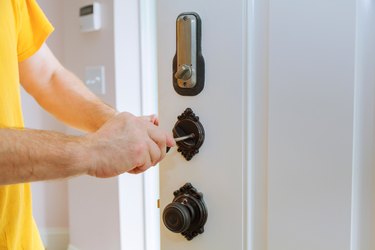
Deadbolts can stick for one of a variety of reasons. The lockset itself may be stuck and in need of lubrication or the door may have fallen out of alignment, wedging the deadbolt barrel against the wood in the jamb. It's also possible the installation of the deadbolt was imperfect. Whatever the reason, if you can't correct the problem with graphite or lubricating fluid, you probably can with a screwdriver, pliers and a hammer.
Lubricating the Lockset
Video of the Day
If the key goes only partially into the deadbolt or it goes all the way in but won't turn, and the locket isn't icebound, you need to lubricate it. It's best to use a bottle of graphite powder for this, but you can use penetrating oil or lubricating fluid, such as WD-40, in a pinch. Insert the applicator nozzle in the key opening and squeeze or spray, then try the key. Assuming it's the right key, it should work after a little wiggling and possibly applying a bit more lubricant.
Video of the Day
If a lock won't work in the dead of winter, it's possible the lockset is icebound. You'll probably need to apply heat, using a hairdryer or heat gun, to get it working again.
Removing the Deadbolt
You've found that you can insert the key and turn it slightly, but that's it. This usually means the barrel is wedged against the jamb. Try lifting on the handle as you turn the key. If that doesn't work, you're going to have to remove the keyset to expose the lock mechanism to free the barrel. To do this, you'll need access to the inside of the door, so hopefully you have another way to get into the house.
Note the two screws holding the lockset escutcheon, commonly referred to as a rosette, to the lock. If you can't see them, remove the rosette by loosening the hex screw on the bottom with an 1/8-inch hex wrench, and you'll find them underneath. Loosen and remove these screws with a screwdriver, then pull off the knob. The keyset will probably fall off on the other side of the door. Just let it go. You can get it when you open the door.
When the lock mechanism is exposed, you'll see a square or hexagonal opening through which the keyset fits. Wedge a flathead screwdriver into this slot, then clamp a pair of pliers onto the screwdriver handle. This arrangement should give you enough leverage to retract the deadbolt when you apply pressure to the pliers. You can also substitute a socket wrench for the screwdriver. Insert a hexagonal bit that fits in the opening into the socket, then use the wrench handle to turn the lock mechanism.
Once you've retracted the deadbolt and the door opens, remove the two screws holding the lock mechanism to the door and pull it out. Repair or replace it as needed.
Take the Door Down
If the unlikely eventuality you can't get the deadbolt to budge, you can always take the door off its hinges. To do this, insert a flathead screwdriver under the top of each hinge pin and tap upward with a hammer to loosen it. Once it starts moving, you should be able to coax it out with the screwdriver or with pliers. After removing all the pins, get a helper to push on the outside of the door while you prepare to catch it. It may take a hefty push, but the door will come down and you'll be able to pull it away from jamb to free the deadbolt.